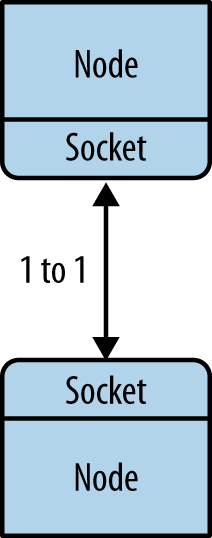Using Sockets to Carry Data
To send and receive messages, you use the zmq_msg_send() and zmq_msg_recv() methods. The names are
conventional, but ÃMQâs I/O model is different enough from the TCP model
(Figure 2-1) that you will need time to get your head
around it.

Figure 2-1. TCP sockets are 1-to-1
Letâs look at the main differences between TCP sockets and ÃMQ sockets when it comes to working with data:
ÃMQ sockets carry messages, like UDP, rather than a stream of bytes as TCP does. A ÃMQ message is length-specified binary data. Weâll come to messages shortly; their design is optimized for performance and so a little tricky.
ÃMQ sockets do their I/O in a background thread. This means that messages arrive in local input queues and are sent from local output queues, no matter what your application is busy doing.
ÃMQ sockets have 1-to-N routing behavior built in, according to the socket type.
The zmq_msg_send() method does
not actually send the message to the socket connection(s). It queues the
message so that the I/O thread can send it asynchronously. It does not
block except in some exception cases. So, the message is not necessarily
sent when zmq_msg_send() returns to
your application.
Get ZeroMQ now with the O’Reilly learning platform.
O’Reilly members experience books, live events, courses curated by job role, and more from O’Reilly and nearly 200 top publishers.

